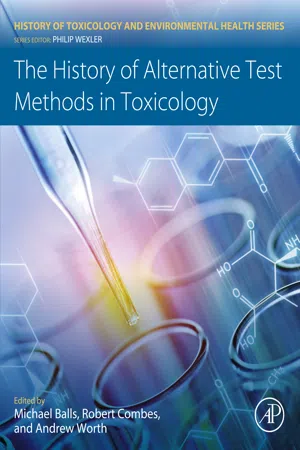
- 352 pages
- English
- ePUB (mobile friendly)
- Available on iOS & Android
About this book
The History of Alternative Test Methods in Toxicology uses a chronological approach to demonstrate how the use of alternative methods has evolved from their conception as adjuncts to traditional animal toxicity tests to replacements for them. This volume in the History of Toxicology and Environmental Health series explores the history of alternative test development, validation, and use, with an emphasis on humanity and good science, in line with the Three Rs (Replacement, Reduction, Refinement) concept expounded by William Russell and Rex Burch in 1959 in their now classic volume, The Principles of Humane Experimental Technique.The book describes the historical development of technologies that have influenced the application of alternatives in toxicology and safety testing. These range from single cell monocultures to sophisticated, miniaturised and microfluidic organism-on-a-chip devices, and also include molecular modelling, chemoinformatics and QSAR analysis, and the use of stem cells, tissue engineering and hollow fibre bioreactors. This has been facilitated by the wider availability of human tissues, advances in tissue culture, analytical and diagnostic methods, increases in computational processing, capabilities, and a greater understanding of cell biology and molecular mechanisms of toxicity.These technological developments have enhanced the range and information content of the toxicity endpoints detected, and therefore the relevance of test systems and data interpretation, while new techniques for non-invasive diagnostic imaging and high resolution detection methods have permitted an increased role for human studies. Several key examples of how these technologies are being harnessed to meet 21st century safety assessment challenges are provided, including their deployment in integrated testing schemes in conjunction with kinetic modelling, and in specialized areas, such as inhalation toxicity studies.The History of Alternative Test Methods in Toxicology uses a chronological approach to demonstrate how the use of alternative methods has evolved from their conception as adjuncts to traditional animal toxicity tests to replacements for them. This volume in the History of Toxicology and Environmental Health series explores the history of alternative test development, validation, and use, with an emphasis on humanity and good science, in line with the Three Rs (Replacement, Reduction, Refinement) concept expounded by William Russell and Rex Burch in 1959 in their now-classic volume, The Principles of Humane Experimental Technique.The book describes the historical development of technologies that have influenced the application of alternatives in toxicology and safety testing. These range from single cell monocultures to sophisticated miniaturised and microfluidic organism-on-a-chip devices, and also include molecular modelling, chemoinformatics and QSAR analysis, and the use of stem cells, tissue engineering and hollow fibre bioreactors. This has been facilitated by the wider availability of human tissues, advances in tissue culture, analytical and diagnostic methods, increases in computational processing capabilities, and a greater understanding of cell biology and molecular mechanisms of toxicity.These technological developments have enhanced the range and information content of the toxicity endpoints detected, and therefore the relevance of test systems and data interpretation, while new techniques for non-invasive diagnostic imaging and high resolution detection methods have permitted an increased role for human studies. Several key examples of how these technologies are being harnessed to meet 21st century safety assessment challenges are provided, including their deployment in integrated testing schemes in conjunction with kinetic modelling, and in specialised areas, such as inhalation toxicity studies.
Frequently asked questions
- Essential is ideal for learners and professionals who enjoy exploring a wide range of subjects. Access the Essential Library with 800,000+ trusted titles and best-sellers across business, personal growth, and the humanities. Includes unlimited reading time and Standard Read Aloud voice.
- Complete: Perfect for advanced learners and researchers needing full, unrestricted access. Unlock 1.4M+ books across hundreds of subjects, including academic and specialized titles. The Complete Plan also includes advanced features like Premium Read Aloud and Research Assistant.
Please note we cannot support devices running on iOS 13 and Android 7 or earlier. Learn more about using the app.
Information
The Introduction and Influence of the Concept of Humane Experimental Technique
Abstract
Keywords
Summary
1. Inhumanity and the Three Rs Concept
2. Progress Following the Publication of The Principles
Table of contents
- Cover image
- Title page
- Table of Contents
- Copyright
- Contributors
- Biographical Notes
- Preface to the Series
- Preface for The History of Alternative Test Methods in Toxicology
- Section 1. Setting the Scene
- Section 2. Contributions From Countries, Regions and Organisations
- Section 3. Important Issues Related to Types of Application
- Section 4. Data Mining and Data Sharing
- Section 5. Key Technologies and Tools
- Section 6. Current Status of Alternatives and Future Prospects
- Index